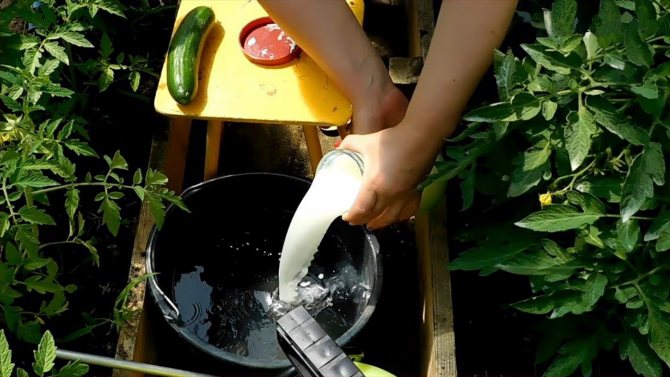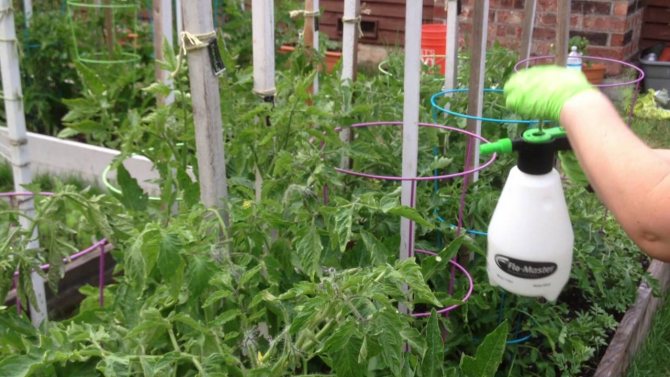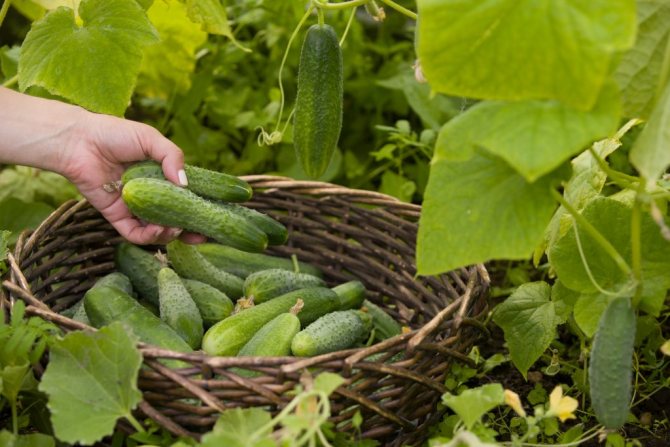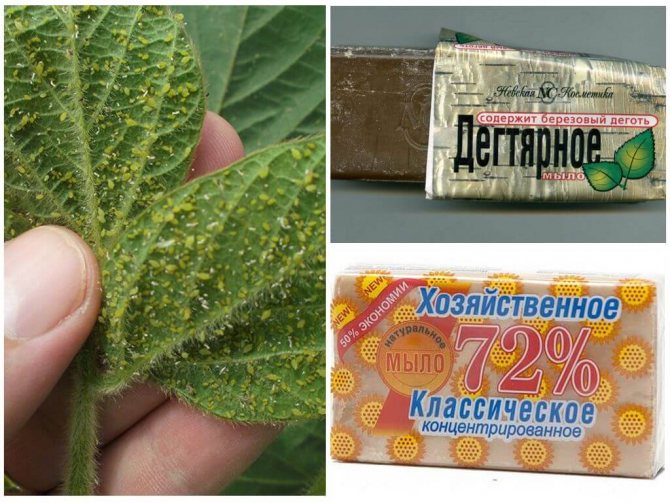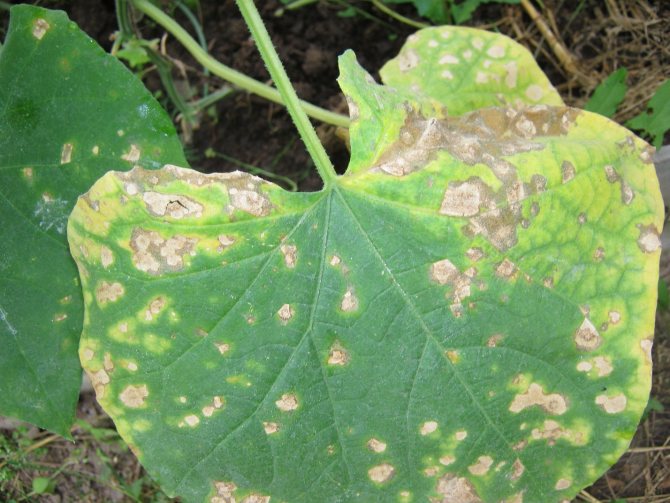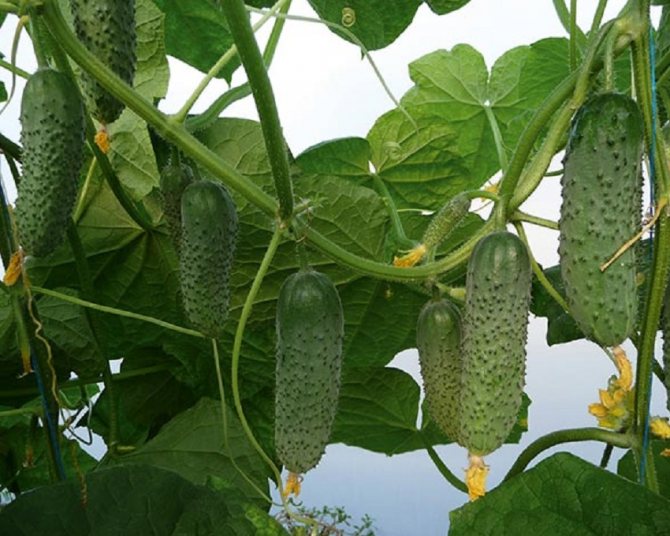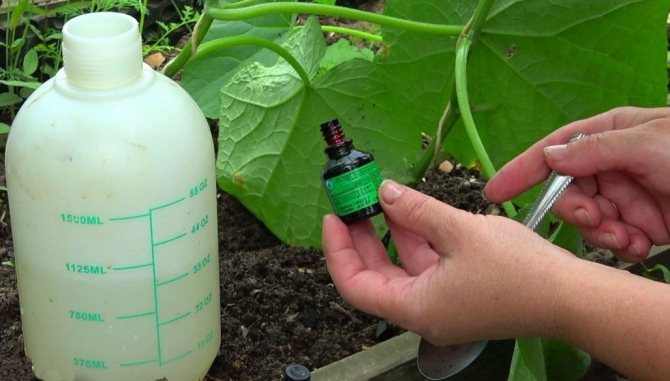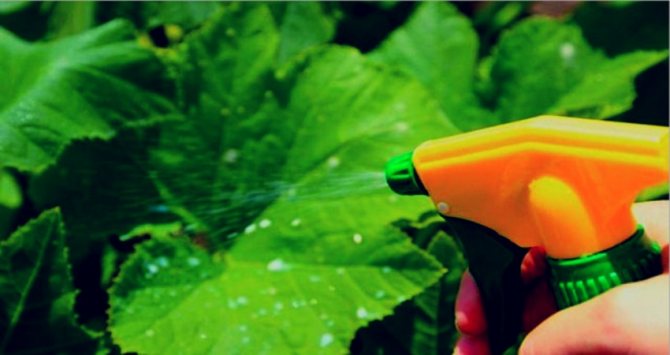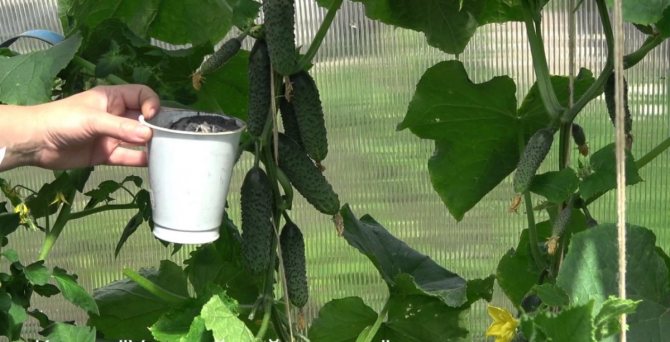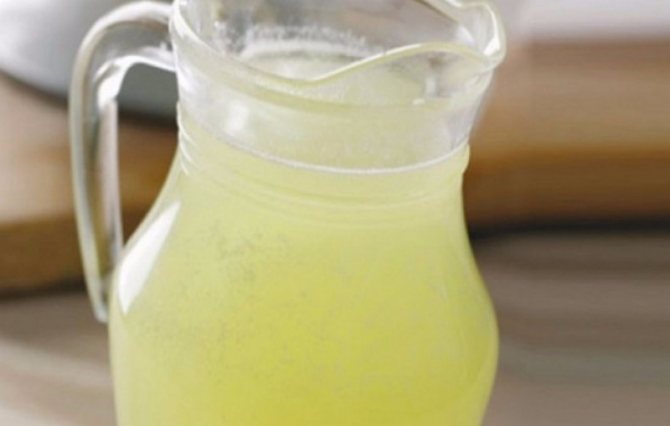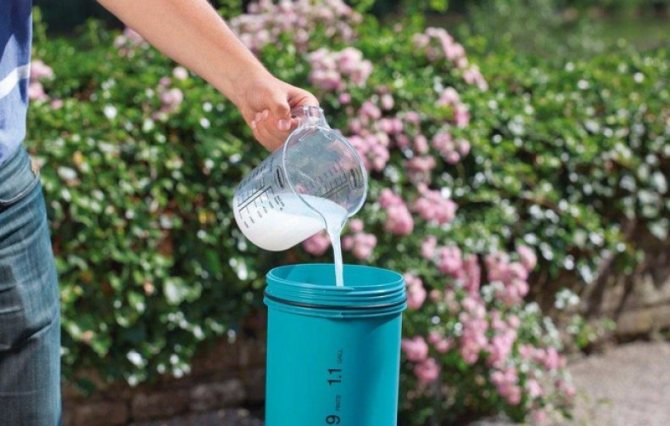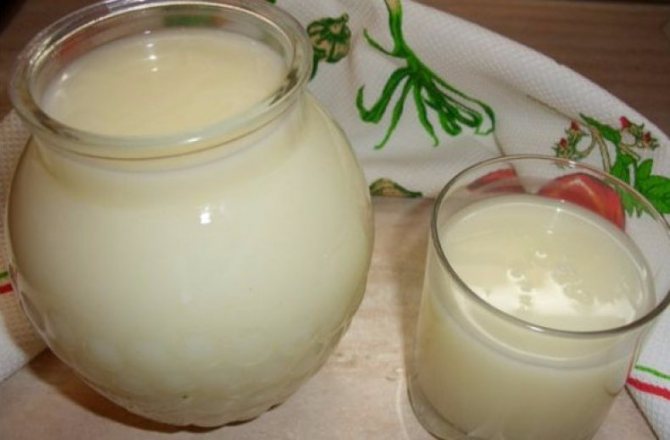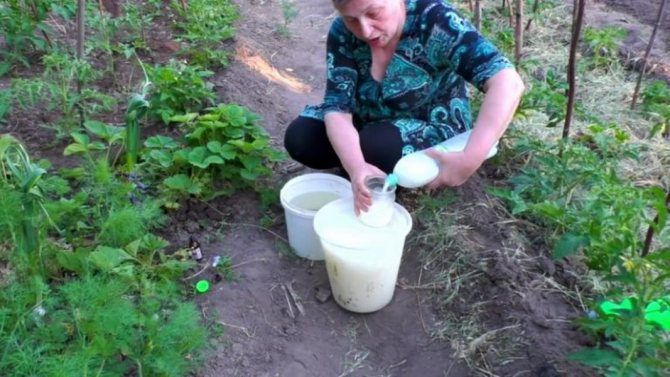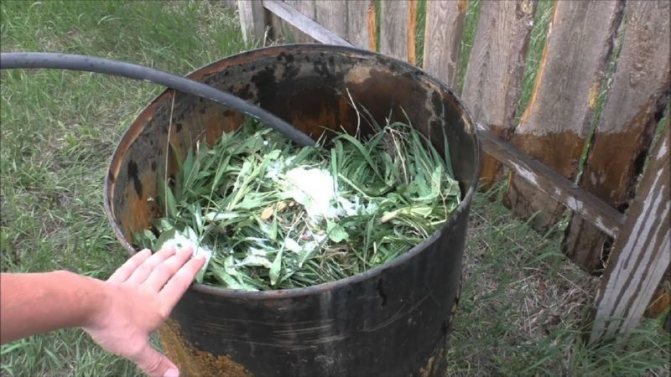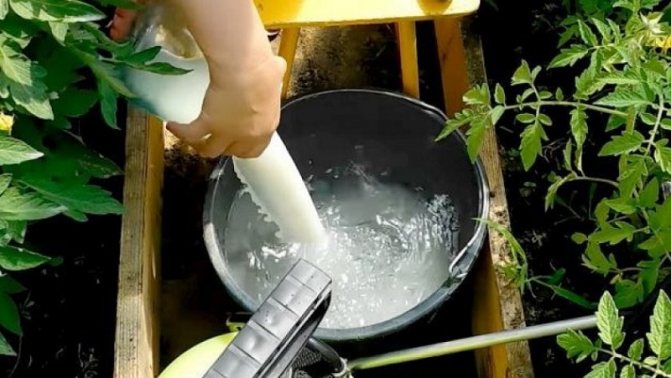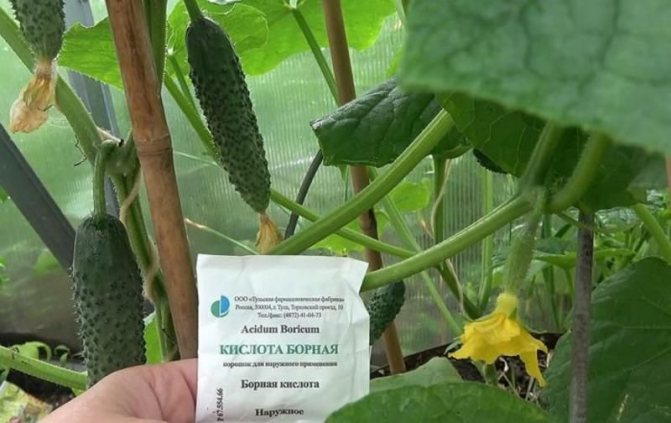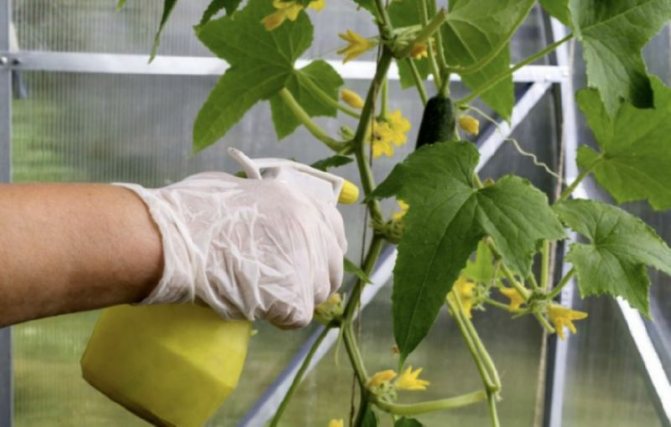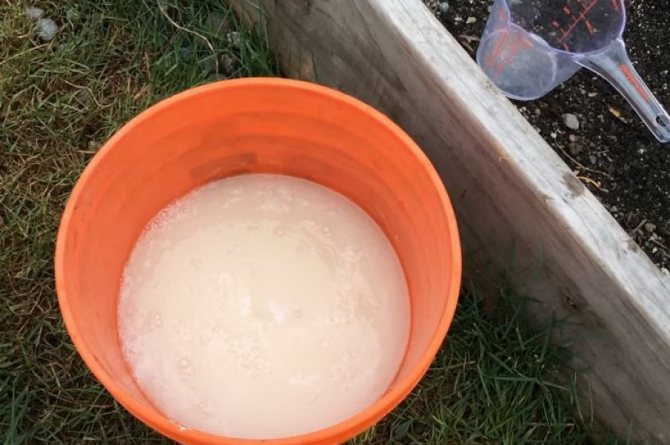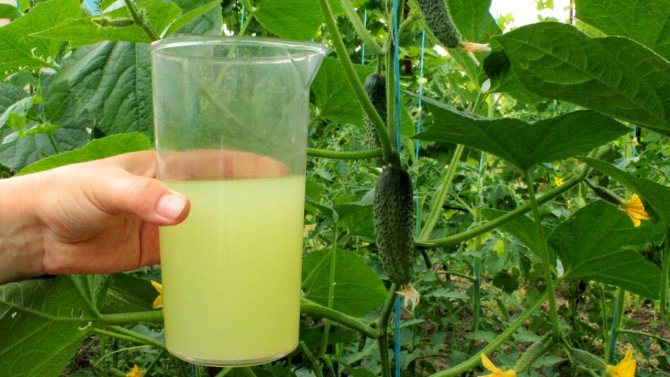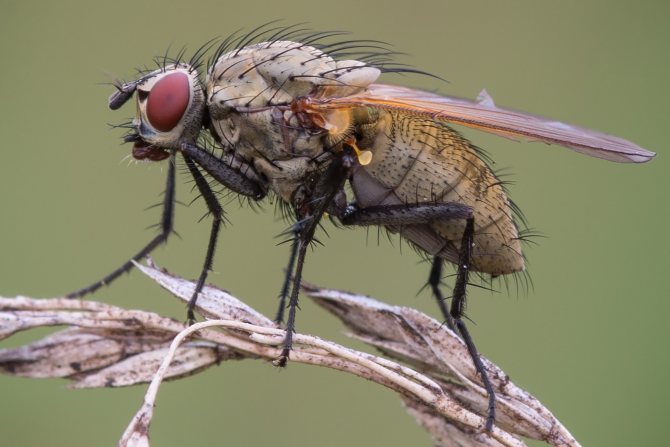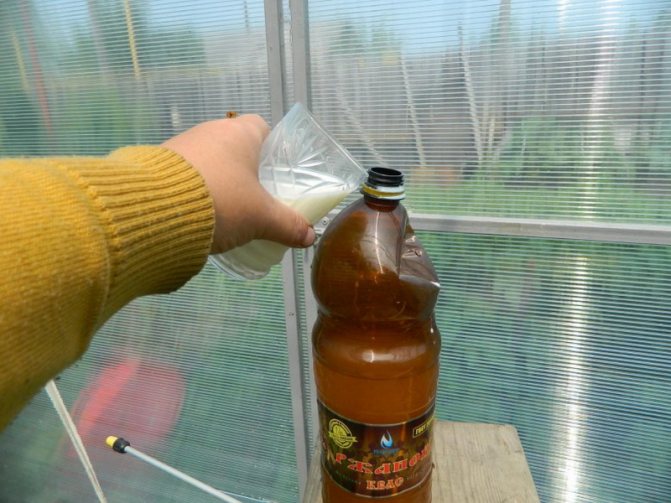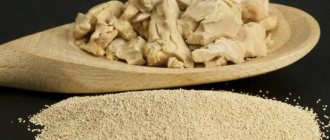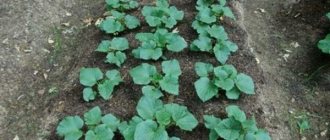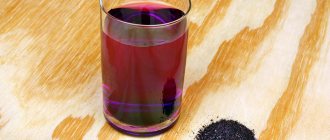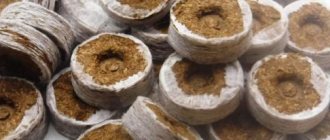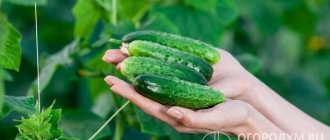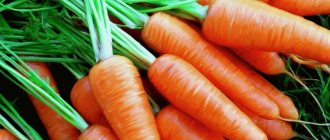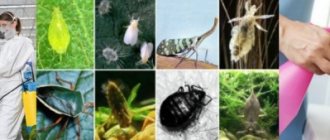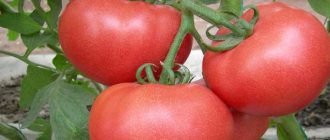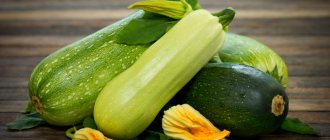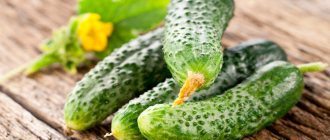The use of whey in the garden
Cucumber and Tomato Serum is often used to prevent the appearance of pathogenic fungal diseases. The substances contained in the drink actively suppress fungi and bacteria without harming the plants themselves. Not sure how to feed your tomatoes? Use serum - it is suitable for both greenhouse seedlings and adult plants.
Growing tomatoes can be sprayed from the beginning of July to provide them with useful amino acids. In addition, serum is an excellent prophylaxis against late blight. An insidious disease, in damp, cloudy weather, appears in many gardens. Prevention from it should be carried out immediately after planting the seedlings, sprinkled with serum. Be sure to remember how to treat tomatoes from late blight, how to deal with the disease.
Whey is a secondary product obtained during milk processing. It consists of 93% water, the rest is the substances contained in milk.
Whey is a useful fertilizer for many garden crops. Most often it is used for feeding cucumbers and tomatoes. Both a store-bought product and a self-prepared product made from kefir or sour milk are effective.
The serum can be used in open beds, greenhouses and greenhouses. The product is suitable for processing young and adult plants.
The serum contains:
- lactose;
- proteins;
- mineral elements;
- amino acids;
- vitamins.
In the garden, this product is highly valued for the content of important amino acids, which are involved in plant growth along with nitrogen, phosphorus and potassium. Lactose protects against pests, monoacid bacteria stop the multiplication of pathogens, the microflora of the product cleans the surface of the leaves from fungi.
Lactic acid inhibits pathogens, promotes greater adhesion of the solution to the leaves. The thin film that forms on the plant protects against the penetration of pathogens and pests.
The serum is used both for introduction into the soil and for foliar processing. The product saturates plants with useful elements necessary for growth, improves their condition, which contributes to an increase in yield.
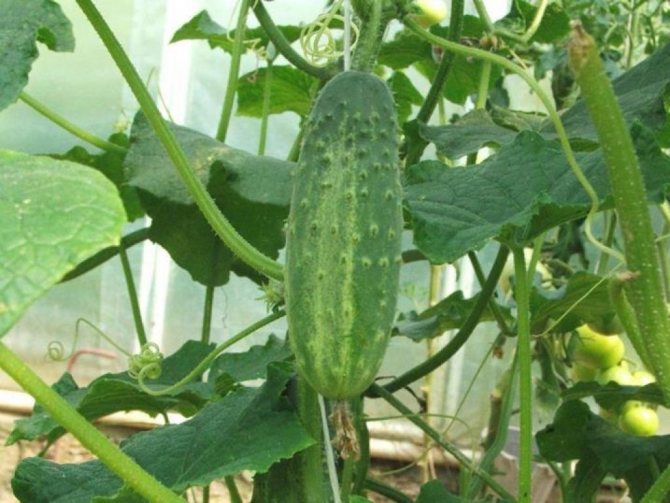
Olga, Kharkov
Alla, Moscow
Treatment of late blight tomato
Late blight can rightfully be called the biggest threat to tomatoes. Experienced summer residents know that the infection almost always affects tomatoes in open ground and greenhouses, most often in the second half of the growing season. The infection is especially dangerous when tomatoes are grown in small areas without changing planting sites or in a greenhouse.
After spraying with serum, a protective film forms on the surface of leaves and stems, which prevents phytopathogens from entering the plant tissue. In a rainy summer, this method is almost useless, since the fermented milk liquid is simply washed off the plants. But in the greenhouse and in dry weather, spraying with the product helps protect the plants from disease.
To protect against disease, adult tomatoes are recommended to be sprayed twice with a solution of whey with iodine at intervals of 8-10 days in mid-July. If possible, late blight prophylaxis can be carried out before the final harvest by spraying the plants every 10 days.
If the disease nevertheless appeared, the treatment of tomatoes should be started immediately. First, all affected plant parts are removed by treating the sections with activated carbon powder. The diseased plant is sprayed with a serum-based agent. Mandatory processing of the soil and neighboring bushes.
Why is serum useful for plants
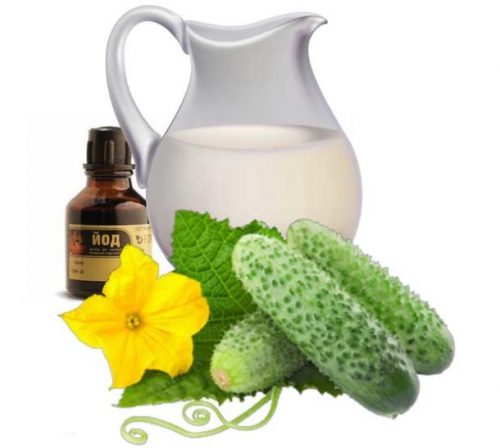

Using milk with iodine avoids chemical feeding
Iodine is the strongest antiseptic and contains many trace elements. And this has a beneficial effect on the growth of cucumbers and prevents the development of the following diseases:
- late blight:
- all types of rot (gray, white, root, wet);
- white and green mosaics;
- copperheads.
In addition, iodine improves the appearance of the plant.
Milk also contains enough nutrients to prevent nutrient deficiencies in the plant. Milk also extinguishes the activity of pathogenic fungi. Therefore, the combination of milk with iodine has a double effect in terms of protecting and nourishing the culture.
The prevention of diseases in plants should be started as soon as 5–6 full-fledged leaves are formed on the seedlings. The procedure is repeated every two weeks. Then outbreaks of disease can be avoided. Iodine with milk will be useful not only for cucumbers, but also for other crops:
- eggplant;
- zucchini;
- tomatoes;
- peppers;
- cabbage.
For seedlings, such feeding is absolutely safe if you adhere to the dosages. Thanks to it, the immunity of plants is increased. The only thing is that it is recommended not to process the seedlings with a milk-iodine composition externally - only root application. This is due to the ability of iodine to cause burns to young foliage.
The product is obtained as a result of souring milk: it remains either after making cottage cheese, or after filtering curdled milk. In the first case, the product contains fewer vitamins, because it undergoes significant heating. For the care of cucumbers, tomatoes, both homemade whey and a drink sold in stores are suitable.
A dairy product is extremely useful: it contains a lot of vitamins, mineral elements, valuable proteins, lactose. When it comes to plants, whey is beneficial for them due to its amino acid content. These substances are of no less value for cucumbers with tomatoes than potassium and phosphorus. The drink perfectly fertilizes the soil, and also fights bacteria that cause dangerous diseases.
What are the advantages of the solution
The product is not used for processing in its pure form. For root processing, the product is diluted with water in a ratio of 1:10. An important condition is that the water temperature must be at room temperature. The solution is poured over the plant under the root and a plot at a distance of 50 cm from it.
For spraying bushes, the concentration of serum is increased, and it is diluted with water in a ratio of 1: 3. For better adhesion of the solution, grated or crushed laundry soap is added to it.
The finished solution cannot be stored for more than 2 days, otherwise the fermented liquid will harm the seedlings.
On the basis of serum, functional solutions are made that allow you to protect against diseases, fertilize the plant and improve its flowering.
Gardeners use serum to prevent late blight and repel insects. To do this, add 10 drops of iodine to the working solution. This pharmaceutical preparation increases the metabolic processes in the plant, enhances the nitrogen exchange process, stimulates plant growth and protects against fungal pathologies.
To improve the effect, the drug "Fitosporin" is added to the solution - it increases the resistance of tomatoes to diseases and pests, and also prolongs the fruiting period.
Serum is also used to prevent powdery mildew. Cucumber leaves are treated with the following solution: 10 liters of water, 1 liter of serum and 13 drops of iodine. The procedure is carried out once every 2 weeks.
At the first sign of illness, emergency measures will be needed to save the crop. The usual working solution will not be able to cope with the disease. The roots and stems of plants are treated with a concentrated solution: 0.5 l of serum and 10 drops of iodine.
To prepare the solution, it is better to use slightly warmed serum. Diseased plants should be sprayed daily, paying special attention to damaged leaves.
This solution can be used to treat both young seedlings and adult plants. For spraying the fruit, the concentrate is diluted with water.
Fertilizer recipe: for 10 liters of water, you will need 2 liters of serum, 10 drops of iodine and 2 tbsp. l. wood ash. It is better to use settled water. The solution is applied under the root or sprinkled with tops.
Downy mildew is a dangerous disease that affects cucumbers. You can treat and prevent the disease with the help of such a solution: 1 liter of water, 1 ml of brilliant green, 0.5 liters of serum and 25 g of urea.
Processing is carried out 3 times a season: before and after flowering, as well as in the first days after the formation of ovaries.
Milk whey improves the flowering of tomatoes and cucumbers. To prepare the solution, use: 2 l of the product, 5 tbsp. l. honey, 10 drops of iodine, 1 glass of ash. Mix the ingredients thoroughly and leave to infuse for 2-3 days. The solution is used for foliar treatments, also for soaking seeds.
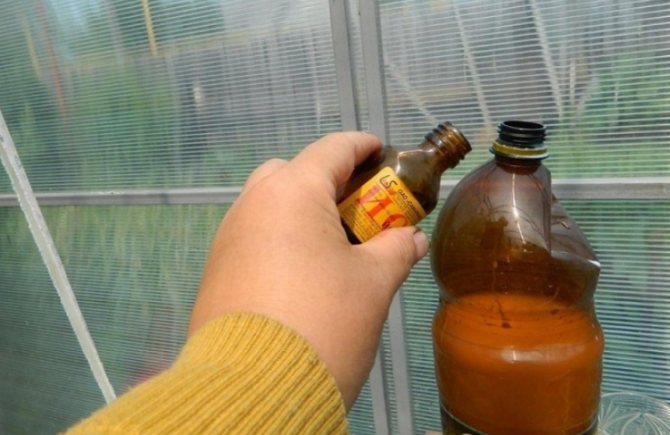

It is very simple to prepare a solution, even if the proportions are not observed exactly, nothing terrible will happen
Let's take a look at the advantages of iodine and whey treatment:
- Availability of all components. It is not difficult to buy serum and iodine, they are sold in all localities and are inexpensive. And those who keep cows have no problems with whey at all.
- Simplicity and safety of preparation. Even a child can prepare a solution. The proportions are easy to observe and even if they are slightly violated, nothing terrible will happen. The composition does not contain toxic and hazardous to health components, therefore, you can prepare a mixture and use it without the use of protective equipment.
- Environmental friendliness of the composition. By treating plants with whey and iodine, you do not increase the amount of nitrates in the soil. Plants do not accumulate any harmful substances and you get an environmentally friendly harvest.
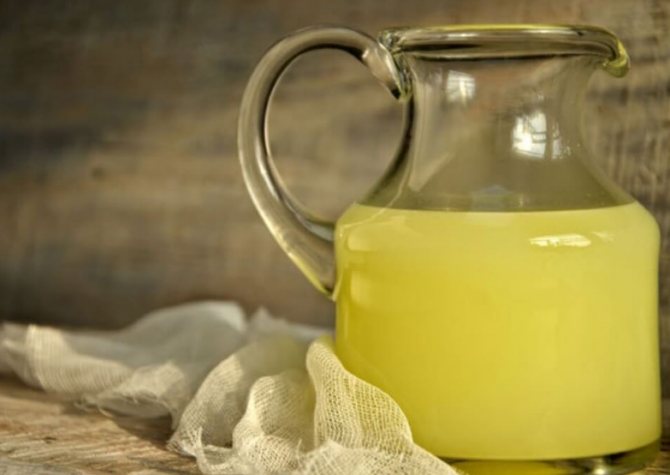

Whey has a number of beneficial characteristics that are further enhanced by the addition of iodine
- High content of minerals, proteins and vitamins. The mixture is very nutritious and has a good effect on the development and growth of cucumbers, stimulating their development. The soil is enriched and the structure becomes lighter, with constant application the general condition of the soil improves.
- The ripening time is shortened and the palatability of the fruit is improved. The plant as a whole bears much better fruit, improves fruit setting and increases the period of fruiting.
- Lactic acid bacteria serve as an excellent prevention and control of diseases. They have a depressing effect on pathogenic microorganisms and destroy them both on the plant and in the soil.
- Versatility of application. The solution is equally good for cucumbers and tomatoes, as well as many other vegetable crops. You can use it without special restrictions, because there are no harmful components in the composition.
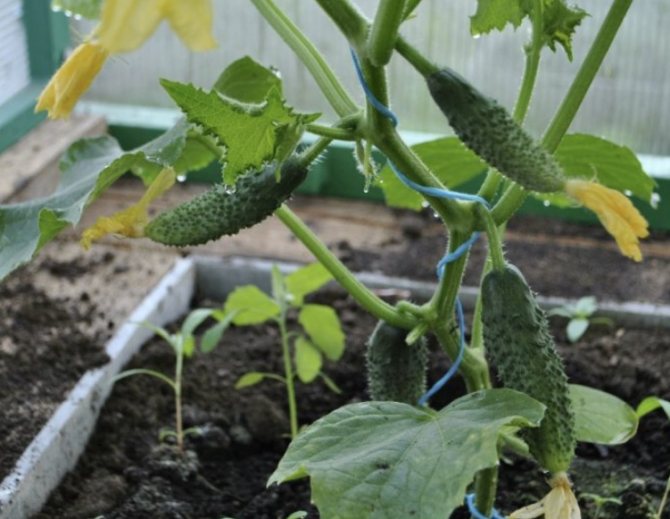

The use of dressings with serum and iodine significantly prolongs the fruiting period and thereby increases the yield.
The author of the video tells the option of prevention using only whey or low-fat milk. A mixture is prepared at the rate of 2 glasses of dairy product per liter of water. Plants are sprayed once a week for prophylaxis.
FEEDING WITH MILK
Milk contains the richest complex of vitamins and unique amino acids; it also contains minerals - calcium, phosphorus, cobalt, molybdenum, potassium, iodine, magnesium, selenium and zinc, necessary for the life and development of plants.
Macro- and microelements in milk are in a form accessible to plants and are assimilated by them without a trace. And the absence of ballast in it in the form of heavy metals, which many purchased fertilizers "sin" with, allows you to get an environmentally friendly harvest.
For seedlings of vegetable crops, I prepare a nutritious cocktail from 0.5 liters of skim milk and 4 liters of settled water.I water the seedlings with such a treat under the root on pre-moistened soil 2 times (a week after germination and after another 14 days).
DO YOU NEED A KEFIRCHIK OR YOUNG MEAT?
A couple of times a season I water the vegetable beds with a solution of whey or kefir prepared in a 1: 9 ratio.
Lactic acid bacteria cause active reproduction of beneficial soil microflora.
This improves the structure of the soil and increases the yield of the plants.
I pour the remains of unnecessary or expired dairy products into the compost heap - the compost ripens faster and is additionally saturated with elements useful for plants.
For nightshades and pumpkin:
shortly before flowering and at the beginning of fruit ripening, I prepare a solution of 1 liter of milk and 9 liters of water and feed the plantings at the rate of 1 liter for each root.
How to properly handle cucumbers
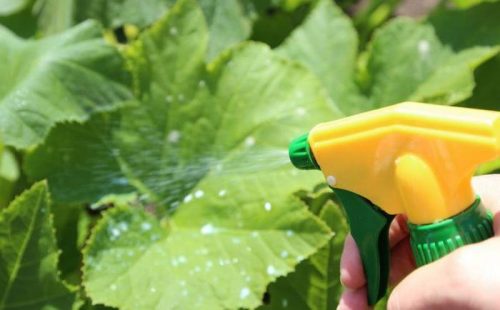

After processing the plantings with iodine with milk, watering is carried out only after a day
Plants are processed in cloudy and cool weather. It is advisable to do this early in the morning or after sunset. The leaves are sprayed with an iodine-milk solution on both sides, and the rest of the product is poured over the soil under the plants. If it rains after the procedure, you will need to repeat everything.
When and how to water? Cucumbers begin to feed 10 days after planting in the garden. Root and foliar treatments are alternated in 1-2 weeks.
Root processing of tomatoes begins a week after planting in a permanent place. The processing procedure is repeated every 7 days.
For watering one bush of cucumbers and tomatoes, 1 liter of solution is enough. After feeding, be sure to water the plant with clean water to rinse the solution off the leaves.
Stems and leaves are sprayed once every 10 days; for strong plants, the number of procedures is reduced to 1 time per month. Young seedlings can be treated with a serum solution every week.
The last feeding of plants with serum is carried out several weeks before harvest. The procedure strengthens the ovaries.
Greenhouse processing
Experienced gardeners do not recommend using a finely dispersed spray bottle for spraying with a solution of milk whey. Small fractions of curd can clog equipment. The procedure is best done with a spray or sprinkle the plants with a broom.
It is not recommended to process the beds during strong winds and precipitation. The best time to carry out the procedure in open beds is early morning or evening, when there is no strong sunlight. Otherwise, there is a high probability of burning the foliage.
If it rains after the treatment, the procedure will need to be repeated. Also, spraying after rainfall will help protect plants from late blight.
These funds can be used as fertilizers, for preventive spraying of cucumbers or for the treatment of diseased plants. For this, an aqueous solution is prepared according to one of the recipes, which are discussed later in the article. Basic recommendations for use:
- the recipe for the preparation of an aqueous solution of antiseptics for spraying cucumbers depends on the purpose of the treatment;
- for prophylactic spraying of plants, the solution must have a low concentration;
- on average, 5-10 ml of green herbs and a few drops of iodine are used for spraying cucumbers in a bucket of water;
- for the treatment and prevention of diseases, an aqueous solution of agents is usually sprayed over cucumbers with a spray bottle;
- to fertilize the soil, it is necessary to water it with a prepared solution of antiseptics, water the cucumbers at the root;
- the time interval between watering or irrigating a plant is usually 6–15 days.
Important! The last spraying with antiseptics is recommended at least 5-7 days before harvest.
Zelenka and iodine are among the available folk remedies for combating diseases of cucumbers.In this case, the greenery has an antiseptic effect, and iodine stimulates the plant's recovery after illness. Experienced gardeners note that after the first treatment of cucumbers with these agents, the condition of the diseased plant improves.
Processing rules
You may be interested in: TOP-10 of the best varieties of medium-sized cucumbers of new selections The best varieties of cucumbers for 2020 for the Moscow region The best hybrids of Polish selection of cucumbers and their features
Despite the fact that there is nothing difficult in using a fermented milk product, in order to get a positive result, it is important to follow the rules:
- Experienced agronomists recommend using the serum for the prevention of diseases for cucumbers a maximum of three times per season.
- At least 1-1.5 weeks should elapse between use.
- To prepare the mixture, the fermented milk product must be diluted with warm water.
- Watering is carried out not directly under the root, but at a distance of 0.5 meters from the culture.
Open field processing should be carried out in the morning or evening, as well as in cloudy weather. And plants in a greenhouse should be sprayed with good ventilation, since condensation forms in a closed structure. These conditions are ideal for the development of powdery mildew and rot.
Spraying foliage can be done on both sides. It is also important to treat the soil around the plant.
Spraying tomatoes with serum with iodine
To save tomatoes from fungal microorganisms, spraying should be done as often as possible. The serum forms a thin film on the leaves, which does not allow garden pests to develop on them. With its help, a full-fledged fight against late blight on tomatoes is possible. The causative agents of the disease will never "touch" the plant under such protection.
If we talk about folk remedies for late blight on tomatoes, it is worth mentioning spraying with serum and iodine. The latter is known for its antimicrobial action, which helps even if the tomatoes are sick. To prepare the mixture, you need to take 10 liters of water, dilute 2 tbsp in it. tablespoons of ash, 10 drops of iodine, a liter of whey. You need to process every 7-10 days. Spraying can be carried out for tomatoes growing in a greenhouse and outdoors.
The use of natural whey is recommended for adult plants and seedlings. You need to take 1 liter of dairy product, 20 drops of iodine, add to 10 liters of water. Stir, feed tomatoes with a healing solution in a greenhouse and open ground. Such feeding will help improve plant growth and increase yields. For 1 adult bush, you can pour 1 liter of the product.
For feeding cucumbers, formulations with milk are often made, and for counteracting pests and diseases - from fermented milk products. Do not exceed the amount of iodine, as this will lower the beneficial properties of milk.
A universal recipe for nourishing and protecting cucumbers:
- Tinder laundry soap (required 35-40 g).
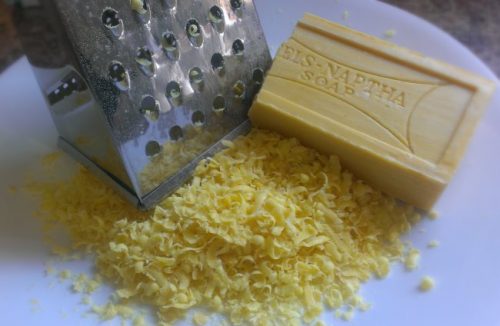

Soap in solution promotes the formation of a protective plaque on the leaves - A water-alcohol solution of iodine is purchased at a pharmacy.


Iodine is purchased at the pharmacy - Milk (1 liter), iodine (25 drops) and soap shavings are added to 9 liters of slightly warmed water.
- All ingredients are thoroughly mixed and immediately start spraying the plants.
You can exchange milk for whey, yogurt or kefir. Then mix one thing with water in equal proportions. Then add the same ingredients as in the previous recipe and mix. At a late stage of infection of cucumber lashes, 10 ml of iodine (1 bottle) will be required. This is how only adult cucumber lashes are processed.
Reviews of gardeners
Olga, Kharkov
Iodine + milk (serum) is from viral diseases. Peronosporosis is a completely different opera, a fungal disease, here fungicides are needed.
Alla, Moscow
If you mix 40 drops of iodine with a liter of whey and a tablespoon of hydrogen peroxide in 10 liters of water, you will get an excellent remedy for fighting the hated late blight. By adding a liter of low-fat milk and 10-12 drops of iodine to 9 liters of water, a solution is obtained that destroys downy mildew on cucumbers.
What sour product goes well with
To saturate vegetable crops with useful minerals and amino acids, the natural mixture goes well with iodine. This composition will protect the cucumber bushes from late blight, which often appears from an excess of moisture.
Due to its specific smell, iodine is an excellent protection against harmful insects.
Preventive measures are best taken immediately after disembarkation. A combination of a sour dairy product and iodine is a great way to strengthen the root system of a vegetable to ensure vigorous plant growth.
Do not think that only iodine has beneficial properties. Knowing how to combine other ingredients correctly can help you make a fertilizer that is as effective as one bought in a store.
From the video you can learn how to prepare a supplement from whey and soda and watch the process of watering her cucumbers.
Yeast is a natural growth stimulant, contains B vitamins, magnesium and active enzymes. It is recommended to combine the bakery product with fertilizers containing potassium, as the yeast helps to wash it out of the soil. It is good to combine yeast with wood ash, as it is rich in magnesium, sulfur, potassium and other elements.
To increase the nitrogen content in the soil, whey is combined with chicken droppings.
The cut grass is a universal product containing all the necessary substances for the development of plants. During fermentation, it releases a large amount of amino acids and beneficial trace elements.
Insect repellent
With the help of serum, you can prepare a composition for combating the main pests of plants - moths and leafworms. To combat them, you can make a fairly effective trap:
- Cut the top half of the plastic bottle, punch holes for the rope tie.
- Fill the resulting vessel a third and hang it on a tree overnight.
In the morning you will see a large variety of insects in the container, including our main opponents.
How to make the best organic vegetable feed?
Now you know that even with the help of available tools, you can create an effective means of helping garden and cultivated plants. Follow the rules of its use and get a rich harvest in the fall.
Pros and cons of whey fertilization
Whey has a number of advantages and disadvantages.
Product pros:
- saturation of the soil with useful trace elements and amino acids;
- increased productivity;
- improving plant development;
- suppression of bacteria and fungi that cause disease;
- treatment of diseases without harm to seedlings;
- use for processing a variety of garden crops;
- acceleration of compost maturation;
- use in the fight against insects.
Disadvantages:
- short-lived effect;
- instability to precipitation.
The serum is short-lived, so it will need to be processed regularly.
Whey is a liquid that is formed as a result of milk processing and remains after curdling and straining. The benefit of the product lies in the fact that its acidic environment has a detrimental effect on pathogenic bacteria. Whey contains a lot of amino acids, proteins and fats; it belongs to natural fungicides.
When fertilizing a cucumber bush, it is important to stick to the correct amount of ingredients. It is important not to overdo it with the components, otherwise it can burn the leaves and destroy the plant as a whole. The product has an acidic composition, which, if used incorrectly, can disrupt the acid-base balance of the soil.The product is not used in its pure form.
You can process the bush to protect against harmful bacteria by using the product with the addition of plain water. For foliar feeding, it is necessary to dilute two glasses of acidic liquid in 1 liter of water.
For spraying, it is better to use a spray bottle. Fertilize with a concentrated product no more than 1 time per month.
This recipe is recommended for watering once every 10 days.
It is necessary to dilute 10 drops of iodine in 1 liter of serum liquid. Combine the mixture with 10 liters of clean water.
In order to water the bush, you need to take 1 liter of the finished liquid. After treatment with the agent, the plant must be watered with water to remove the remaining solution.
In case of late blight disease, this method can be used for spraying from a spray bottle.
If the summer resident has free time, then you can prepare a good top dressing from nettle and sour product. To do this, you will need a large container, into which you should pour chopped nettle. Next, you need to add 6 liters of water and 3 liters of whey, cover with a lid and put in a dark place to ferment for 2 weeks. After a while, the ready-made solution is used for feeding, diluting 1 liter of infusion in a bucket of water.
This feeding method is only suitable for root processing. In case of contact with foliage, rinse the culture with clean water. To prepare the composition according to this recipe, you can use any other weed.
You can try a faster and easier herbal fertilization method. For him, you need to prepare freshly cut grass by mixing it with 3 liters of sour milk or kefir. Let it brew for a couple of days, and then dilute in a bucket of water. Process the roots, avoiding contact with the leaves.
This method will protect the plant from earthen inhabitants that can harm the crop. To prepare the product, you will need 1 liter of milk or whey, 1 tbsp. l. laundry soap, 25 drops of iodine. Mix all the ingredients in a bucket of water and let it brew a little. Spray once a week with the prepared composition.
A recipe that has become a salvation for gardeners, because thanks to it you can get rid of fungal diseases that disrupt the proper growth and development of culture. It is required to mix 2 liters of sour milk with 10 liters of pure water. It is enough to spray with a ready-made solution once every 10 days to get rid of fungal diseases. The tool fights well against yellowed foliage, saturating the bush with vitamins and minerals.
During the period of plant growth, it is necessary to carry out top dressing, which will contribute to yield and prevent yellowing of the leaves.
To do this, you need to dilute 1 glass of sugar in 3 liters of kefir or other dairy product. Water the cucumber bushes with a means, and spray from the spray bottle. Usually after this, new ovaries are formed, which will give good fruits in the future.
Precautions
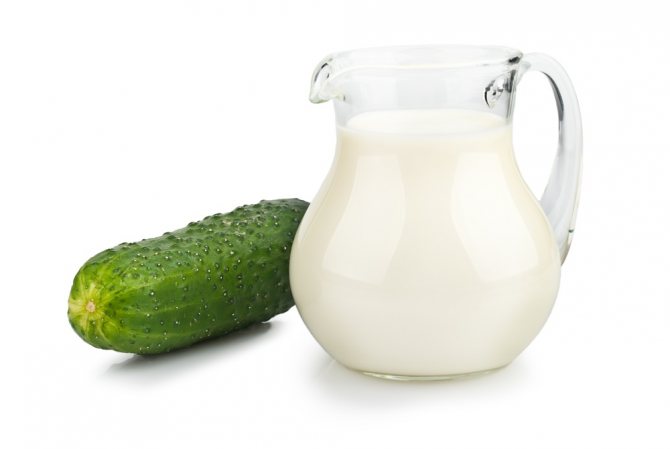

The main thing when using whey is not to overdo it, otherwise the acid balance of the soil can be disturbed. And this, in turn, has a detrimental effect on plant health. Undiluted product can burn the root system and leaves.
Attention!
Whey is not harmful to humans, but people with dairy allergies still need to be careful.
Even the simplest methods have features. Gardeners have developed the following recommendations:
- the water for the solution should be warm (23-24 degrees) and settled;
- it is better to use fresh whey, without heat treatment;
- do not exceed the ratio of the components according to the recipe;
- apply the solution immediately on the day of preparation. Otherwise, pathogens may appear in it.
The use of milk fermentation product is good because it does not harm the plant at any stage of development. In addition, it is not harmful to beneficial insects.
Disease prevention
Milk whey not only fertilizes the soil, but also contributes to the destruction of dangerous pathogens that cause disease.
Experienced gardeners use it against such diseases:
- late blight;
- powdery mildew;
- rust;
- fusarium;
- scab;
- leaf spot.
Preventive treatments are carried out 2-3 times a month. Remove dry leaves and rotten stems before the procedure. For spraying, use a solution of serum diluted with water in a ratio of 1: 3.

